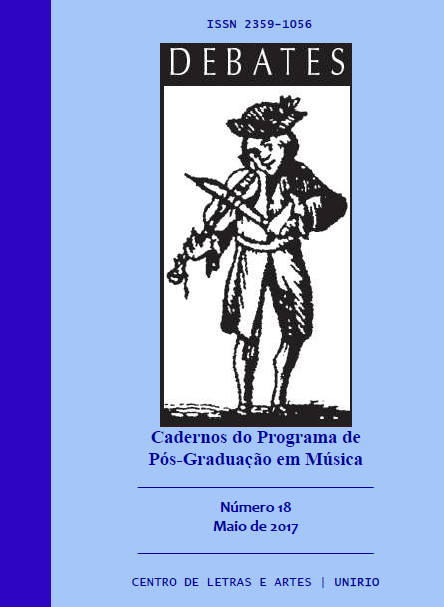Brincadeiras cantadas: uma experiência didática piagetiana para a educação musical
Resumo
Resumo: a formação conceitual, técnica e pedagógica dos professores para ensinar música é uma preocupação da área de Educação Musical. Por essa razão, desenvolvemos uma metodologia de trabalho com adaptação do método clínico piagetiano com uso de brincadeiras cantadas. Investigamos os efeitos dessa intervenção sobre a aprendizagem da estrutura rítmica binária de alunos de 6ª série / 7º ano do ensino fundamental. A coleta dos dados foi realizada no período de aula regular dos alunos por meio de filmagens e anotações de campo, durante quatro sessões de noventa minutos. Os dados revelaram um movimento progressivo dos estudantes em direção à construção da estrutura rítmica binária, que foram divididas em três etapas de análise: Etapa I - Percepção do Tempo Forte (TF) e do tempo fraco (tf); Etapa II – Conservação do padrão métrico binário TF e tf independente da variação da expressão musical e Etapa III – Compreensão do prolongar e subdividir do tempo métrico. A identificação e compreensão do tempo forte / tempo fraco por parte dos alunos foi considerada fundamental para acompanhar o movimento do grupo em direção ao conhecimento da estrutura rítmica binária. Concluímos que as brincadeiras cantadas apoiadas em uma metodologia construtivista são ferramentas de ensino adequadas para a aprendizagem do ritmo binário, demonstrando a fecundidade desse referencial para a educação musical.
Palavras-chave: Educação. Educação Musical. Teoria Piagetiana
Sung jokes: a piagetian teaching experience for musical education
Abstract: The conceptual, technical and pedagogical training of teachers to teach music is a concern of the Music Education area. For this reason, we have developed a methodology of work with adaptation of the Piagetian clinical method with use of sung jokes. We investigate the effects of this intervention on learning of the binary rhythmic structure of students of 6th / 7th grade of elementary school. The data collection was carried out during the period of the students’ regular class, though filming and field notes, during four ninety minute sessions. The data revealed a progressive movement of the students towards the construction of the binary rhythmic structure, which were divided into three stages of analysis: Stage I - Perception of the Strong Time (ST) and the weak time (wt); Stage II - Conservation of the binary metric standard ST and wt independent of’ the variation of the musical expression and Stage III - Understanding of the prolonging and subdividing of the metric time. The identification and understanding of the strong time / weak time by the students was considered fundamental to follow the movement of the group towards the knowledge of the binary rhythmic structure. We conclude that the sung plays supported by a constructivist methodology are adequated teaching tools for learning the binary rhythm, demonstrating the fecundity of this referential for musical education.
Keywords: Education. Musical education. Piagetian Theory


